What Is the Reading on Each of the Scales?
Piano scales are an important part of developing your playing skills and understanding the building blocks of music. They aid enormously to understand key signatures.
If you have ever wondered why pianists play them, how they work and what the benefits are then yous are in the right identify. With a elementary formula you lot will larn to play major, minor and dejection scales. If you lot contain a few minutes of learning and practicing scales into your daily schedule, yous'll soon run into the advantages of making time for scales.
What are pianoforte scales?
What is a calibration? Musical Scales are usually misunderstood, but they are really quite simple. Scales are a grouping of notes, in alphabetical order, that are a specific distance apart from each other. We retrieve of scales as having ii parts, a root and a quality.
In the F major scale, the Root is "F", which is the note that we begin counting our scale from, it is our offset letter in our musical alphabet in this scale.
The quality of the F major scale is major. This means our pattern of whole steps and half steps will be the exact same as every other "Major Scale". Then, even though an F Major Calibration and an A Major Scale take different Root Notes, their scale "Qualities" are the same. This is why nosotros are going to teach you the pianoforte scales for beginners. Starting with the pattern for all major scales, and then you will larn all of the scales simultaneously, instead of merely i.
To begin, here is a Skoove lesson to practice and familiarize yourself with the C Major in the left manus. To help you while this can be a little difficult, the Skoove app waits for you to play the right note before the app introduces you lot to new music.
Whole-steps and half-steps – the edifice blocks of scales
Before learning how to build these scales hither is a reminder of Whole Steps and Half Steps.
- Half Step: This is the smallest distance on the piano. It occurs between whatever key and it'southward firsthand nearest fundamental. This does non mean from white to black, or from white-to-white. Information technology ways the immediate nearest notation, above or below.
- Whole Step: A whole footstep is two half steps in either management. You can remember this considering two halves make a whole, two half-steps brand a whole-step.
Why exercise scales?
Practicing scales is the key to cognition of the pianoforte. Not only do they increase your sensation of fundamental signatures, but they also lead to finger endurance and muscle retentivity. Your speed playing scales volition plough into conviction and ease in pieces of music you play. There are and so many productive ways you tin do scales and arpeggios that volition make playing them fun rather than a chore! In addition to practicing in the circle of fifths , here are some corking ideas to comprise into your daily do:
6 tips for practicing your scales
At that place are and so many productive ways yous can do scales that will brand playing them fun rather than a chore! Hither are some dandy ideas to incorporate into your daily practice:
- Effort playing in different octaves with both hands.
- Apply an online metronome . This is a very well tried method of getting even, speedy scales that yet stays pop, because information technology works!
- Try a different key every calendar week. This will assistance you larn your keys and key signatures actually well.
- Keep a practise diary to tape all your practice sessions. This way y'all can track your progress really well and see what does and doesn't piece of work for you lot.
- Use different rhythms. Using a dotted annotation rhythm with a long note first is ever a skillful start. Playingin unlike speeds and using different rhythms is great strengthening practise for your fingers . It's a brain work-out too, while you're learning new scales.
- Practice more than than one octave at a time. One time you've got it flowing and very even, you want to accelerate to two octaves, then three and eventually, four.
💡 Click hither to bound down to the piano scales generator
Dissimilar types of pianoforte scales
The most mutual types of scale are major scales, small scales and the blues scale. Let'south look at each type. Remember what was written in the introduction. Scales take ii parts, a Root and a Quality. Here we will focus on learning the different Qualities of Scales. First nosotros look at Major.
Understanding the major scales
Major scales are usually associated with upbeat and optimistic music. To build a major calibration you follow this blueprint of semitones and tones. Major Scales are the most common in all music, and they are the starting place for most every pianist.
Root – Whole-Pace – Whole-Step – Half-Stride – Whole-Step – Whole-Stride – Whole-Step – One-half-Step
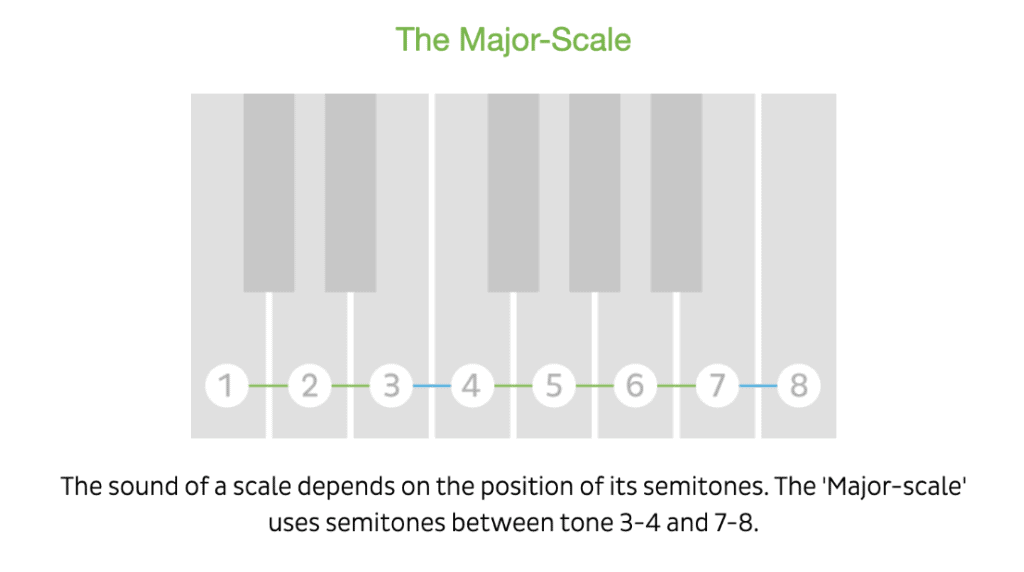
Don't forget about minor scales
In that location are iii primary different types of small-scale scales: natural, harmonic and melodic.
While major scales sound quite happy, minor scales audio mysterious, sad, or exotic. They are often used to express more complex emotions. Pay attention to how the calibration degrees are different than major. The construction of a natural small calibration looks like this:
The first modest scale: the natural modest scale
A, B, C, D, East, F, G, A
Tonic – Tone – Semitone – Tone – Tone – Semitone – Tone – Tone
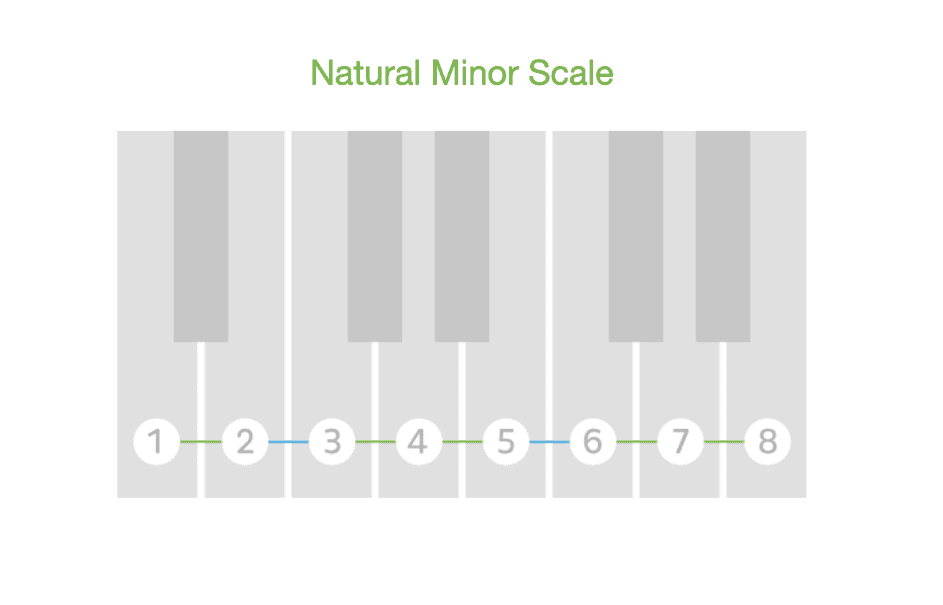
This scale uses the same fingering design equally the C-major scale above. "Mad World" by Tears For Fears introduces the A minor scale. Learn the A-pocket-size scale in the related Skoove lesson. Skoove will give you guidance and instant feedback on your playing.
The natural modest calibration is also called 'aeolian' scale. The semitones are betwixt annotation ii-3 and 5-six.
The 2nd minor scale: the harmonic modest scale
The harmonic scale is notable for its raised 7th note which does not announced in the key signature. This raised seventh means there is an interval of 3 semitones betwixt the sixth and 7th note. This is the most usually used small-scale scale in western music. The structure looks like this:
Tonic – Tone – Semitone -Tone – Tone – Semitone – 3 semitones – Semitone
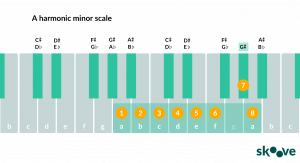
The tertiary minor scale: the melodic modest scale
To create a "melodic minor" scale, you still flatten the tertiary annotation of the scale, but you raise both the 6th and 7th notes past a half-pace going up. Coming down, you flatten both the 6th and 7th scale-degrees, and then the scale is very different going up from coming down.
Ascending: Tonic – Tone – Semitone – Tone – Tone – Tone – Tone – Semitone
Descending: Tonic – Tone – Tone – Semitone – Tone – Tone – Semitone – Tone
This is an advanced Scale Design, so don't worry nearly skipping it and coming back to information technology. It sounds like a major and modest scales been played at the aforementioned time.
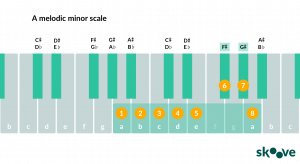
Practicing contrary motility in scales
Opposite – meaning opposite – and motility – meaning movement. These are scales that move in opposite directions and are fun to play. Sure keys are really challenging to play in this mode, just give you the adjacent level of skill if you practice them !
C major is the easiest one to play. To play a opposite motility scale in C major, start with both your thumbs on middle C. Your left paw is going to perform a descending scale while your correct hand is going to perform an ascending scale, at the aforementioned time. The trick to this is that it is actually quite like shooting fish in a barrel, when you realize your hands are using the verbal same fingering, simply moving apart and then toward each other.
Only five notes: the major pentatonic scale
Another very commonly used scale in blues, jazz and fifty-fifty popular music is the Pentatonic scale. Information technology'due south a shorter scale, consisting of six notes, (if you double the root note at the top), and information technology has a major and minor variation. The major pentatonic is structured similar this:
Root – Whole-Pace – Whole-Pace – 3 Half-Steps – Whole-Step – 3 Half-Steps
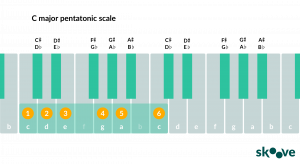
Play a modest dejection with the small-scale pentatonic scale
The small-scale pentatonic is structured like this:
Root – 3 Half-Steps – Whole-Pace – Whole-Step – 3 One-half-Steps – Whole-Steps
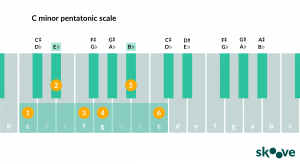
How to play dejection scales
The blues scale has a very distinctive sound. Yous can fifty-fifty exercise your first blues improvisation with Skoove.
The pattern of tones and semitones is this:
Root – 3 Half-Steps – Whole-Step – Half-Stride – Half-Step – three Half-Steps – Whole-Footstep
By following this pattern, y'all can play the blues scale starting on any piano key.
Don't forget about the whole tone calibration
This type of calibration sounds rather "ethereal" and romantic. Claude Debussy used this calibration frequently in his music. Heed to "La Mer" bundled for two pianos to go the sense of wonder that this scale conjures.
The structure is simply every bit its name implies:
Root – Whole-Stride – Whole-Step – Whole-Step – Whole-Stride – Whole-Step
Piano Scales Generator
This piano scales generator from Pianoworld is handy tool to learn scales. It is interactive and easy to use.
If you are reading this from a mobile device, rotate it to display the tool in full width.
1. Click on "Calibration"
2. Choose the "Root" of the scale
2. Choose the "Blazon" (major, minor, etc.)
iii. Click "Brandish"
* You can practise the same with scales.
** You can invert chords and scales
Summing up the scales
Exploring new and interesting calibration patterns can lead to some very interesting results. Mayhap you will try a new scale and call up of sadness, or sunlight, or outer space, or something crazy like the chromatic scale ! You tin can even effort combining your new scales with basic piano chords
In that location is a reason why composers and pianists of all skill levels practice scales, because they are the key to learning nearly new major keys and new means to express yourself. The all-time way to acquire to express yourself with the piano is past taking online piano lessons , and using the new Pianoforte App Skoove'south Free Trial!
Writer of this blog post:

Source: https://www.skoove.com/blog/piano-scales/